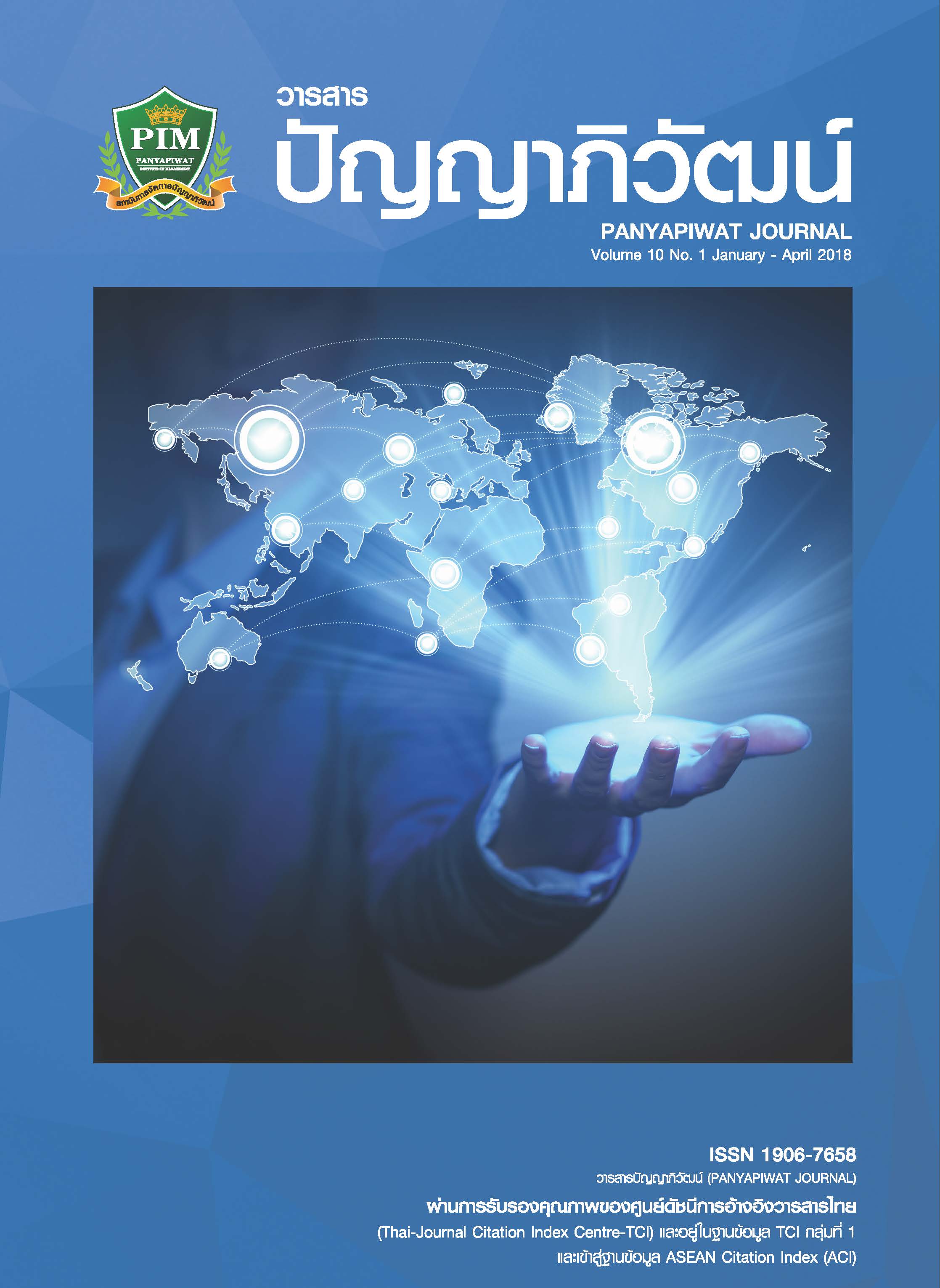การใช้ภาษาเพื่อการโฆษณาในนิตยสารวัยรุ่น
Main Article Content
บทคัดย่อ
การศึกษาวิจัยครั้งนี้มีวัตถุประสงค์เพื่อศึกษาลักษณะการใช้ภาษาหรือการเปลี่ยนแปลงของภาษาเพื่อการโฆษณาในนิตยสารวัยรุ่น ปี พ.ศ. 2556 โดยวิเคราะห์เนื้อหาเฉพาะส่วนที่เป็นวัจนภาษา ได้แก่ ลักษณะการใช้คำ การใช้สำนวน และการใช้ประโยคบนโฆษณาในนิตยสาร Seventeen และนิตยสาร ELLE พบว่า ลักษณะการใช้ภาษาในนิตยสารวัยรุ่นมีความเหมือนกันในภาพรวมส่วนใหญ่ แต่มีความถี่ของการใช้ภาษาที่แตกต่างกันคือ ด้านการใช้คำทั้งสองฉบับมีลักษณะตรงกันคือ ด้านการใช้คำสัมผัส การใช้คำภาษาต่างประเทศ การใช้คำซ้ำ การใช้เครื่องหมายวรรคตอน และการใช้คำซ้อน ด้านการใช้สำนวนมีลักษณะตรงกันคือ การใช้สำนวนภาษาต่างประเทศ การใช้สำนวนภาษาพูด และการใช้สำนวนภาษาเปรียบเทียบ และด้านการใช้ประโยคมีลักษณะตรงกันคือ การเรียงลำดับส่วนประกอบของประโยคอย่างอิสระ การละส่วนประกอบบางส่วนของประโยค และการผูกประโยคยาวที่มีเนื้อหาซับซ้อน ดังนั้น จึงมีข้อเสนอแนะเชิงปฏิบัติเพื่อเป็นประโยชน์ต่อผู้สนใจด้านการสื่อสาร และสื่อมวลชนที่ใช้ภาษาโฆษณาเป็นเครื่องมือในการสื่อสาร ควรกำหนดมาตรฐานด้วยหลักไวยากรณ์การใช้ภาษาที่ถูกต้องเป็นลำดับแรก และผสานเข้ากับหลักการโน้มน้าวใจตามวัตถุประสงค์ของการโฆษณา เพื่อผลดีต่อการรับรู้และการใช้ภาษาของผู้รับสาร และเป็นการเปลี่ยนแปลงทัศนคติด้านการใช้ภาษาเพื่อการโฆษณาของสื่อมวลชนได้อีกนัยหนึ่ง
The objective of this research was to study language of advertising and its transformation in teen magazines in year 2013. It analyzed content, i.e. verbal communication including the use of words, proverbs, and sentences in Seventeen and ELLE magazines. The findings revealed that, predominantly, there were no differences in language of advertising in these two teen magazines. In details, in terms of the use of words, the two teen magazines shared Rhymes, Foreign Language Loanwords, Punctuation Marks, Repetitive Words and Semantic Doublets. Likewise, the advertisements in these two magazines similarly enjoyed using proverbs of Idioms, Colloquialism and Similes and Metaphors. Last but not least, no divergence was found in these magazines commercials’ sentences including how the sentence parts and structures were formed independently, how certain parts of the sentences were omitted and how to structure long and complicated sentences. This research contributes a practical suggestion for a communicator and, especially an advertiser who should concern the usage of proper and correct grammar most. Advertising purposes should be considered afterwards. Otherwise, appreciation cannot be created among consumers.
Article Details
“ข้าพเจ้าและผู้เขียนร่วม (ถ้ามี) ขอรับรองว่า บทความที่เสนอมานี้ยังไม่เคยได้รับการตีพิมพ์และไม่ได้อยู่ระหว่างกระบวนการพิจารณาลงตีพิมพ์ในวารสารหรือแหล่งเผยแพร่อื่นใด ข้าพเจ้าและผู้เขียนร่วมยอมรับหลักเกณฑ์การพิจารณาต้นฉบับ ทั้งยินยอมให้กองบรรณาธิการมีสิทธิ์พิจารณาและตรวจแก้ต้นฉบับได้ตามที่เห็นสมควร พร้อมนี้ขอมอบลิขสิทธิ์บทความที่ได้รับการตีพิมพ์ให้แก่สถาบันการจัดการปัญญาภิวัฒน์หากมีการฟ้องร้องเรื่องการละเมิดลิขสิทธิ์เกี่ยวกับภาพ กราฟ ข้อความส่วนใดส่วนหนึ่งและ/หรือข้อคิดเห็นที่ปรากฏในบทความข้าพเจ้าและผู้เขียนร่วมยินยอมรับผิดชอบแต่เพียงฝ่ายเดียว”
เอกสารอ้างอิง
Chalermmeeprasert, P. (2007). Communicative language in advertising. FMS Journal, 3(5), 48. [in Thai]
Chanprakon, V. (2007). Thai usage for communication (2nd ed.). Bangkok: Triple Group. [in Thai]
Cholvisoot, T. (2010). The study of language usage for communication via www.pantip.com for developing the understanding in mass media language course. Research report. Lampang: Lampang Rajabhat University. [in Thai]
Doungdee, P. (2001). An analytical study of the teenagers' colloquialisms in Thai fims during 1996-1997. Master's thesis, Prince of Songkla University. [in Thai]
Kosiyakul, K. (2002). The style of language and the myth in cosmetic advertising in women magazine. Bangkok: Thai Theses Database. [in Thai]
Limkulacomn, S. (1991). Strategies of word use in Thai in television and magazine advertising. Master's thesis, Chulalongkorn University. [in Thai]
Nanthachankul, S. (2000). The study of influence of teen magazines on Thai usage among bachelor students Kasetsart University. Humanities Journal, 8(1), 1-19. [in Thai]
Pilanthaowat, O. (2011). Persuasive communication (6th ed.). Bangkok: Chulalongkorn University Press. [in Thai]
Ponghanpanit, S. (2004). The comparative study of Thai usage in advertisement between the teenage journals and the adult journals. Master's thesis, Kasetsart University. [in Thai]
Saengchan, B. (2012). Behavior and attitude of teenagers in Bangkok toward chat language. Master's thesis, Sripatum University. [in Thai]
Sariukl, B. (2010). An analysis of language in cosmetic advertising fliers in 2008. Srinakharinwirot Research and Development (Journal of Humanities and Social Sciences), 4(7), 42-56. [in Thai]
Satawedin, P. (2003). Introduction to communication arts (10th ed.). Bangkok: Pappim Publisher. [in Thai]
Satawedin, P. (2003). Mass communication: Process and theory (3d ed.). Bangkok Pappim Publisher. [in Thai]
Singkakuldacha, A. (2002). An evolution of advertising language in children products in magazines for mothers and children during 1978-1998. Master's thesis, The University of the Thai Chamber of Commerce. [in Thai]
Sirichai, P. (2008). The characteristics of descriptive structure in using verbal and non-verbal language in Kham Proy on the VCD of Thai movies. Master's thesis, Kasetsart University. [in Thai]
Sundaravibhata, T. (2010). Advanced creative strategy (7th ed.). Patumthani: Bangkok University. [in Thai]
Wimmer, R. D. & Dominick, J. R. (1987). Mass Media Research an Introduction (2nd ed.). Belmont: Wadsworth Publishing.
Wongpinunwatana, W. (1994). The analysis of language used in teenage magzaine. Research report. Khon Kaen: Faculty of Humanities and Social Sciences, Khon Kaen University. [in Thai]
Yiemkuntitavorn, S. (2014). Change your thought to improve English for communication. Panyapiwat Journal, 5(Special Issue), 220. [in Thai]
Yutibun, S. (2010). Features, usage and meanings of slang in teen magazines. Master's thesis, Silpakorn University. [in Thai]


